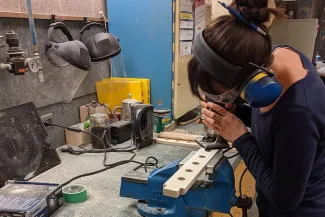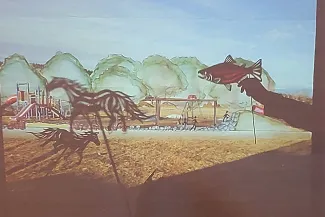"Trust your own process and remember to have fun"

Ivana Lexa-French
- Degree:
- Master of Landscape Architecture
- Grad year: 2022
- Program:
I grew up in Aarhus, Denmark. My mother worked in the performing arts, so we were often on the road and I spent many hours entertaining myself by drawing. At age 14, I moved to San Francisco, California and studied music at a high school for the arts. My international upbringing became an interesting aspect in navigating between cultural worlds. At age 19, I moved to Edinburgh, Scotland, where I did a Master’s in Social Anthropology with Development. I did my anthropology fieldwork in the northern Philippines, learning about Indigenous land management from the Ifugao community and I became fascinated with the relationship between identity and landscape. After graduating, I moved to Laos and worked there for 10 years teaching English and Environmental Management. I love teaching. However, I also love working creatively. Coming to UBC to study Landscape Architecture has offered creativity in a practical realm, and I’ve been able to weave together many threads of my life experiences such as drawing, education and community development. I also think it’s important to do certain things for your own sake, so I make music and food with my husband and we enjoy having that creative freedom together.
Why did you choose to go into your field of study at UBC?
I had a number of design interests entering the program, one of them being risky play and children’s landscapes. I was excited to learn about Susan Herrington’s research in these areas. I’ve been fortunate to receive Susan’s guidance on a number of projects, including my graduate project. She secured funding from the Faculty of Applied Science for Indigenous engagement and integrated my directed studies on Indigenous plant knowledge into her studio. Susan is part of PRO-ECO, a project studying nature play at preschools led by Dr. Mariana Brussoni, which I have been part of as well. In my final year, I joined Susan Herrington’s vertical design studio, Rewilding Play, where I had the opportunity to work on a design intervention for a preschool in Vancouver. The UBC Master of Landscape Architecture offers hands-on experience through design builds, which attracted me to the program. Design school projects often end in a digitized and somewhat hypothetical world, but in this studio we were engaging with educators, meeting the students, sourcing materials, putting plants in the ground and using fabrication tools to build our designs in the workshop. We experienced tangible obstacles and opportunities that really changed my perspectives on design.

What has made your time at UBC memorable?
In my second year, I was in John Bass’ design studio, the Indigenous In-Between. The studio was based on a partnership with members of the Tsilhqot’in Nation, who have fought hard to reclaim and develop their ancestral lands. One of my most significant experiences at UBC was meeting the leaders of this community and working with them to design projects supporting their development goals. The studio contextualized landscape architecture in relation to Indigenous land values. It also provided an avenue for me to connect with other communities through my studies. I developed this connection further through my graduate project and designed a schoolyard for one of the Tsilhqot’in band-lead schools. I made several site visits and met with the teachers and students to really understand what they needed as a basis for the design. It felt good to use all the hours poured into a thesis to support the needs of a community.

Tell us about your experience in your program. What have you learned that is most valuable?
One of the biggest skills this program develops is teamwork. Landscape architecture is based on group work and it is a fairly broad field, so everyone brings their own areas of specialization to the group. I have classmates with backgrounds in environmental science, forestry, fine arts, communications, industrial design, and literature, and I came in with a social science background. We all have different strengths and weaknesses. As group projects develop, it feels like we’re each adding our own unique ingredients, and then the flavours merge into a symbiotic stew that none of us could have created on our own. The better I’ve gotten to know my cohort, the more interesting it has become to recognize each individual’s influence and see how it emerges within a group. I’ve made so many good friends through this process and I truly hope I get opportunities to continue working with these amazing people in some capacity.
What advice would you give a student entering your degree program?
Design is a process. At the start of the degree, our instructors structured the process for us. However, I gradually started finding my own way of developing concepts, getting them out of my head onto paper, and then communicating them in some measured way. It’s all very intuitive. My advice is to trust your own process and work however is most efficient- and also most enjoyable! I’ve been drawing my whole life, so my hand is like a second brain, whereas the computer feels like a clunky surrogate limb. I have classmates that experience the inverse. Everyone works differently. In the end, there is never enough time to do as much as we want. So, I think it’s about figuring out a workflow that allows us to work effectively and also to focus on the parts of the process we enjoy the most. An important element of creativity is being playful, and while we’re working hard, we need to make space for playful thinking in our work.
Where do you find your inspiration for using your degree to make an impact on our world?
Designing spaces is about designing for the beings that will use that space. A landscape is never a blank canvas, it is layers of complex social and environmental systems. As a designer, I see my role as synthesizing elements of these systems to enhance the experience for everyone. I start a project by asking myself, how can we transform this space materially, experientially and socially, to support the needs of the community using it? A necessary part of my design process is to talk to the people that use the space or learn about the wildlife that inhabits the area. I am motivated by meeting people who use the space and hearing their stories of how they relate to the space and what they want to see. Working in a space that carries deep meaning for people adds a certain pressure and unfortunately, you can never please everyone. However, I hope that my designs will create little moments of meaning for people, and observing these moments definitely inspires me to keep doing it.
What are some contributions you would like to make when it comes to the future of work in your field?
I’m gravitating towards designing children’s landscapes. I enjoy how much children engage with the spaces around them. Adults usually walk through a space, sit in it and look around, but kids really get into the landscape- they might roll around, turn it into characters or try to eat it. The curiosity and imagination children bring to a space are crucial aspects of their physical, emotional and intellectual development. Unfortunately, I don’t think a lot of the landscapes designed for children respond to this adequately. I think North America is an increasingly risk-averse culture, but the research I’ve been involved with indicates that children benefit from more freedom outdoors. Additionally, we tend to confine learning to the indoors, but I think this separation between knowledge and landscape is troubling. I see a lot of potential to rethink outdoor learning spaces for all ages of students. Regular and thoughtful interactions between children and landscapes can foster that innate environmental consciousness we need to sustain our species. This sort of reciprocity can extend to all ages, and I hope to make contributions that engage people with landscapes through design.



